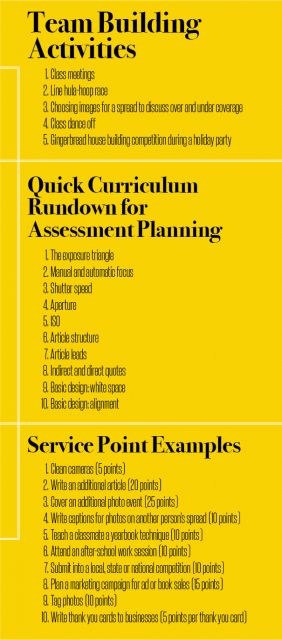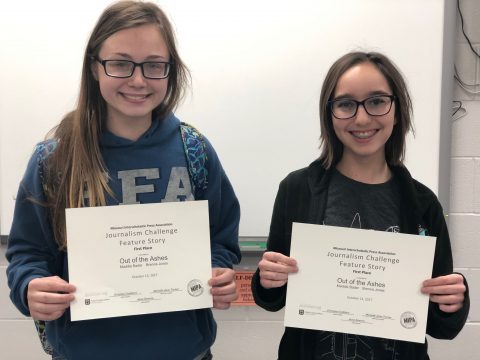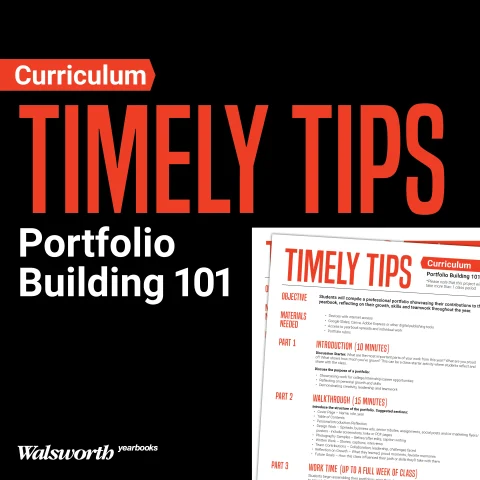Updated by Walsworth Yearbooks
Grading the yearbook is difficult and often leads to more questions than answers when designing a curriculum to meet your school policy. Without traditional assignments and exams, the bulk of the grades focus on the deadlines leading up to the finished product of your yearbook.
This can be achieved by dividing assignments into four categories: weekly, quarterly, semesterly and overall assessment or classwork. While I still adjust my grading, curriculum and teaching every year based on the needs of my staff, this system has worked well for us.
Inform Parents Immediately
Grading yearbook is unlike other grading. Some students have a completed grade on an assignment, others are marked missing or incomplete and others are marked exempt. To help parents prepare for this unique structure, I email parents during the first week to explain the grading structure, how assignments will stretch through the semester and the expectations for yearbook. I inform parents and students that grades can drop quickly before or after a grading period if a deadline was not met and encourage parents and students to check grades regularly. I keep parents updated as we approach big deadlines through a parent group email – email contact groups are an easy way to get those out quickly. If contact needs to be made because a student is not meeting deadlines, I reach out to the parents through a phone call.
 The Crossword Gradebook
The Crossword Gradebook
Students are encouraged to turn in assignments early so I can have more 1:1 and small group conferencing with them about their work. I schedule time to give feedback immediately after their homecoming article is finished so I’m not worried about giving feedback on their volleyball article until it is ready the following week. My students have soft due dates prior to the hard deadline, which allows conference and feedback time. Technically, their due date is not until quarter grades are due, but I ask after the event is over, “Could you have this finished by Tuesday so we can go over it?”
Weekly progress reports (mentioned below) hold students accountable for soft due dates without a hard points penalty in the deadline category of the grade book. Because students turn in assignments and we conference at different times, I grade them immediately. The process works as follows: Student completes assignments and submits. I schedule a 1:1 conference time with them to review it. The student makes corrections during the conference time and plans to collect any additional information needed. A deadline to get that information is set and listed on the weekly goals progress sheet. When that information has been obtained, the student resubmits. I review and grade. Because of the conference time, grading is much easier in the end and the final grading process largely acts as a pass-fail. Did the student complete the feedback work? If yes, full points have been obtained. If no, the assignment remains incomplete in the grade book.
Our grade book allows teachers to write comments next to each assignment. Because the assignments in the gradebook may be vague like, “Quarter 1 article” or “Event 1 Coverage,” I write a quick summary of each student’s assignment as I put in grades.
Weekly progress reports
To get a grade in the grade book, my students complete weekly progress reports. At the beginning of the week, students write down everything they are working on and set goals for each item. By the end of the week, students give me an update as to what was accomplished. I score how they used their time out of 10 points. I also walk around each class and monitor student work while I conference with other students. I score students in a hand notebook on a scale of 1-5: 1 – time was used poorly, little work was accomplished; 5 – time was used well, student stayed focused and on task. I review these scores when I grade the weekly progress reports to determine if time wasted resulted in incomplete tasks.
Virtual Learning Accommodation: This assignment can be used in a virtual learning setting by eliminating the walk around. Instead, grade on work completion based on the weekly progress report. Encourage detailed responses and where the work can be found. If a student wrote 10 captions, they should write: Wrote 10 captions. Captions can be found on the divider spread, student life spread, etc. I left a post-it note in Online Design with my name on the captions I wrote.
Team building and class meeting participation points
Students need to work together in fun, stress-free ways to make the stressful moments bearable. We do a team building activity at least once a month. I give students points for these activities depending on what they are. If it is a game, I give the students service points. If it is a critical thinking activity or a short open written response, I give the students participation points.
Virtual Learning Accommodation: Students can share a selfie representing what virtually learning from home is like or do online interviews with each other over topics like their favorite childhood memory, building interview skills and relationships, and share the recording with the teacher. Students can also do a weekly scavenger photo hunt and share their photos. For example, find something red and take a selfie with it. Use online platforms like Google Meet and Zoom to conduct class meetings.

Assessment quizzes
Each week, we do a short 15 to 30-minute lesson on marketing, photography basics (shutter speed, aperture, etc.), copy writing or design. Simple assessment allows me to grade largely with participation points. When we learn about photography composition, I have a 15-minute activity after where they practice what they learned on their camera phones. I ask them to show their favorite image and explain what composition technique they used. These lessons allow me to create short 10-question quizzes if I want to combine a few lessons together. I want deadlines to take priority in the grade book, so I usually place these assessments in the classwork section of the grade book. This way, poor performance will not hurt a grade significantly since other class activities balance out this section of the gradebook. These assessments also help me quickly identify which students need 1:1 or small group conferencing.
Biweekly News Moment Capture
Strong captions for photos used to be a battle. The quotes were weak and generic, and I struggled getting coverage of smaller events such as bake sales. To enhance caption writing and get more widespread coverage, I introduced the biweekly news moment captures. Students photograph events in and out of school, then write a caption for the photo. A student could capture one photo from an event, enhance coverage in the yearbook and develop caption writing experience. These assignments work great as yearbook space fillers. To maximize student coverage, we focus on students who are not already featured. Students pull these up, and I walk around and grade with quick feedback to make this manageable.
Semester podcast assignment

I introduced the semester podcast assignment because past articles lacked genuine personal perspective and I wanted students to enhance their skills in interviewing. Students completed interviews within a ten-minute time span. Rarely did the reporter deviate from their pre-mapped questions or ask follow up questions. Requiring students to interview for 20-30 minutes forced them out of their comfort zones. We watched Celeste Headlee’s “10 Ways to Have a Better Conversation” TEDTalk and discussed how good interviews should feel more like conversations than simple Q&A sessions. Stronger interviews resulted than I had seen in six years of teaching. Students developed great content, enhanced communication skills and we had a wealth of resources to choose from for potential articles for the yearbook. A student could go in, type out of the interview, make the copy fit the structure of an article, and we had additional articles.
Semester Photo Events Coverage
To create a fair balance of event coverage, develop photography skills across the whole staff and lighten the workload for students prone to cover many events, each yearbook staff member is required to go to five photo events each semester. They must take, at minimum, 25 strong compositional photojournalistic images. Pictures with weak composition, poor exposure or other struggles do not count. This encourages students to develop basic photography skills and enhance coverage. Students must upload and organize their images to get the event points.
Service points
I created the service points assignment because I found a multitude of tasks that needed to be completed, yet could not easily have an assignment attached to it (i.e., camera cleaning, coverage on an additional article, sorting through yearbook receipts, proofing ads, etc.). Each semester, students must accumulate 200 service points. They get a list of tasks with service points assigned to each one. Events also need to be completed, such as grabbing an interview for a caption, polling students on a question or creating an infographic for a spread. Students and editors put tasks they need completed in a running spreadsheet in our Google team drive where I assign points to the task. Then someone signs up to complete the task. If the receipt was filed correctly, I sign off on the task, and the student earns the service points. If the assignment is not completed, service points for that assignment are not awarded. This allows students freedom in picking assignments they are more interested in, such as the student who is more interested in photography who chooses to sign up to cover extra events.





